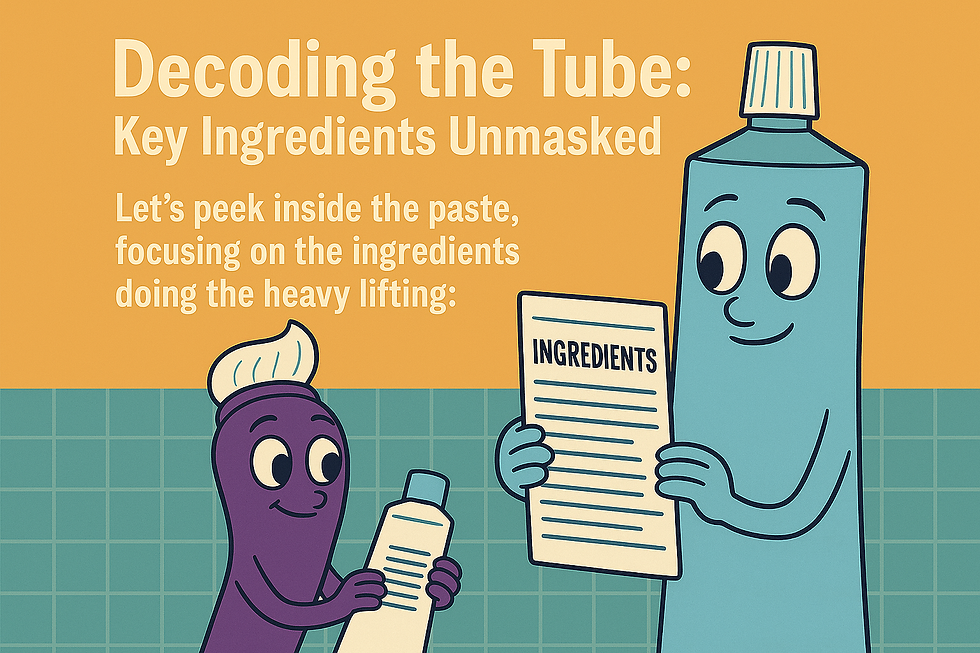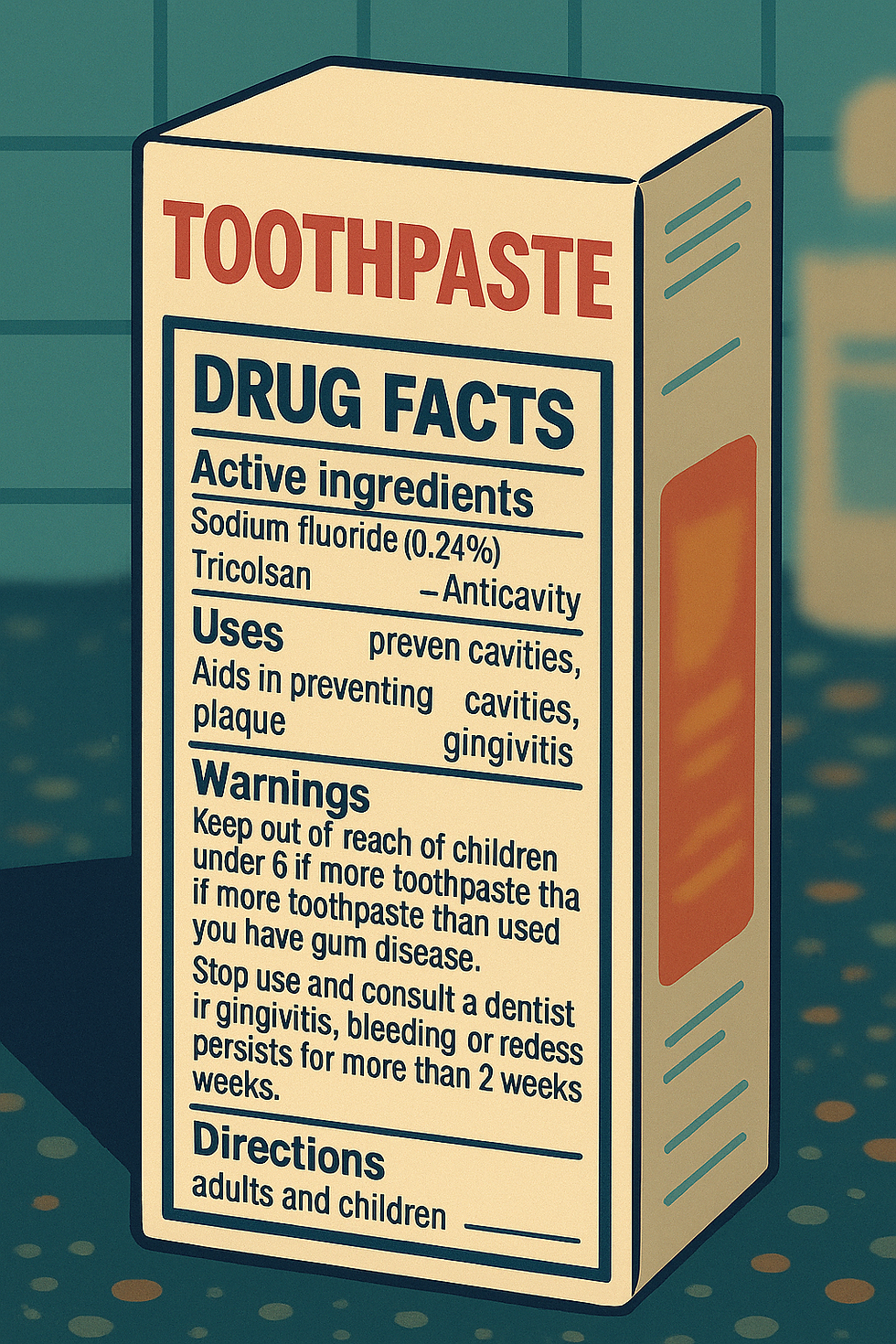Toothpaste
- naytoghlo
- Apr 22, 2025
- 5 min read

Toothpaste Tangle: Your Guide to Decoding the Dental Aisle!
Hey Smile Superstars! Dr. Noor here.
Ever stood in the toothpaste aisle feeling like you need a map and a compass? Rows upon rows of tubes shouting about whitening, sensitivity, cavity protection, natural ingredients... it's a veritable toothpaste jungle out there! Brenda the Brush needs a trusty sidekick, but how do you choose the right one when there are so many options?
Fear not! Today, we're squeezing the truth out of toothpaste tubes. We'll decode the labels, understand the key players (ingredients!), and help you find the perfect partner for your pearly whites (and Brenda!).
The Basic Mission: What's Toothpaste Supposed to Do?
At its core, all toothpaste aims to help your toothbrush (Hi, Brenda!) do its job better. Its main goals are:
Remove Plaque: That sticky film of bacteria we're always fighting.
Remove Food Debris: Leftovers from your latest snack attack.
Polish Teeth: Gently buffing away surface stains.
Deliver Active Ingredients: This is where things get interesting – ingredients for cavity fighting, sensitivity relief, etc.

Key Ingredients:
Abrasives (The Gentle Scrubbers): Mild ingredients like calcium carbonate, hydrated silica, or hydrated alumina provide the grit. Gentle is key.
Humectants (The Moisture Keepers): Glycerol, sorbitol keep it from drying out.
Detergents (The Bubble Makers): Sodium Lauryl Sulfate (SLS) is common for foam; SLS-free options exist for sensitive mouths.
Flavoring & Sweeteners (The Yum Factor): Makes brushing less of a chore!
Thickeners/Binders (The Texture Masters): Give paste its consistency.
Preservatives (The Freshness Guards): Keep the tube contents stable.
NOW, The ACTIVE Ingredients – The Real MVPs:
This is where brands often differentiate, targeting specific problems. You'll see these listed separately on the box under "Active Ingredients":

Fluoride (The Cavity Shield): The undisputed champ for strengthening enamel and fighting decay. Common types you'll see:
Sodium Fluoride (NaF): A widely used, effective anti-cavity agent found in many standard toothpastes (like many Colgate varieties).
Sodium Monofluorophosphate (MFP): Another common fluoride source.
Stannous Fluoride (SnF2): This one's a multi-tasker! It fights cavities PLUS helps with sensitivity (by blocking tubules) AND has anti-bacterial properties that can help fight gingivitis (gum inflammation). You'll find it in various Colgate Total versions and some Sensodyne products. It can sometimes cause minor surface staining, but formulations have improved greatly.
Anti-Sensitivity Agents (The Nerve Calmers & Tubule Blockers): If hot or cold makes you wince, these are your heroes:
Potassium Nitrate: This is the classic ingredient in many Sensodyne formulas. It works by calming the nerve activity inside the tooth, preventing the pain signal from reaching the brain. Think of it as turning down the volume on nerve sensitivity.
Stannous Fluoride (SnF2): Remember our multi-tasker? In sensitivity pastes (like some Sensodyne Repair & Protect or Colgate Sensitive Pro-Relief variants), it works differently than potassium nitrate. It physically blocks the tiny microscopic tubules in your dentin (the layer under enamel) that lead to the nerve. No pathway = no ouch!
Arginine Bicarbonate/Calcium Carbonate (Pro-Argin Technology): Found in some Colgate Sensitive Pro-Relief pastes, this technology also works by physically plugging the dentin tubules.
Xylitol (The Sweet Surprise with Anti-Cavity Benefits!): As mentioned, this natural sweetener disrupts cavity-causing bacteria. While often a supporting ingredient, in products like CariØ by Oral Science, it takes center stage as the primary anti-cavity agent in a high concentration (25%), offering a fluoride-free alternative.
Anti-Tartar Agents (The Formation Blockers):
Pyrophosphates / Zinc Citrate: Found in "Tartar Control" formulas. They don't remove existing hard tartar (only scaling does that!), but they help prevent new plaque from hardening into calculus above the gumline.
Why the Aisle Feels Like Déjà Vu:
You might notice many different boxes from various brands all listing "Stannous Fluoride" or "Potassium Nitrate." So, what gives?

Same Core Tech: Often, the core active ingredient targeting the main problem (sensitivity, cavities) is the same or similar across brands.
Different Formulations: Brands tweak the inactive ingredients (flavors, foaming agents, abrasives, thickeners) to create a different user experience (taste, texture, foam level).
Secondary Benefits: A paste might use Stannous Fluoride primarily for sensitivity but also market its anti-cavity and anti-gingivitis properties. Another might focus only on the sensitivity aspect in its marketing.
Marketing Magic: Let's be honest, branding and packaging play a huge role!
The Key Takeaway: Look past the flashy claims on the front and check the "Active Ingredients" list on the back. This tells you the main job the toothpaste is designed to do based on its scientifically proven components.

Fluoride-Free Fighters (Like CariØ!): As discussed, CariØ uses high-concentration Xylitol instead of fluoride, targeting the bacteria side of the cavity equation. A great science-backed alternative! (More on fluoride vs. fluoride-free here)
Whitening Warriors: Usually rely on boosted abrasives or low levels of chemical whiteners (like hydrogen peroxide) for surface stain removal. (Deep dive into whitening here)
The Charcoal Controversy: Charcoal toothpaste has become trendy, claiming whitening and detoxifying benefits. However, proceed with caution!
Abrasiveness: Many charcoal pastes are highly abrasive and can potentially wear down enamel over time.
Fluoride: Most lack fluoride, missing out on that key cavity protection.
Effectiveness: Evidence for significant whitening beyond surface stain removal is limited.
(Want the full scoop on charcoal and other trends like oil pulling? I've got you covered)
Sensitivity Soothers: Contain ingredients like potassium nitrate or stannous fluoride that help block the tiny tubules in dentin (the layer beneath enamel) that lead to nerve endings, reducing sensitivity to hot, cold, or sweet stimuli.
Tartar Control Titans: Include ingredients like pyrophosphates or zinc citrate that help prevent new tartar (calculus) from forming above the gumline. They don't remove existing tartar – only a professional cleaning can do that!

Kids' Corner: Pastes for Tiny Tots:
Children's toothpaste is specially formulated:
Fluoride Levels: Often contain lower fluoride levels or are fluoride-free for very young children who might swallow paste (too much ingested fluoride can cause fluorosis). Always check the age recommendations!
Abrasiveness: Generally less abrasive than adult pastes.
Flavors: Come in kid-friendly flavors (berry, bubblegum) to make brushing more appealing.
Amount Matters: For kids under 3, use only a smear the size of a rice grain. For kids 3-6, a pea-sized amount is plenty.
So, How Do You Choose?!

Look for the Seal: In many countries, look for a dental association seal of approval (like the ADA Seal of Acceptance in the US or CDA Seal in Canada). This means the product has been evaluated for safety and effectiveness.
Consider Your Needs: Are you prone to cavities? (Fluoride or high-Xylitol might be key). Sensitive teeth? Look for sensitivity formulas. Want brighter teeth? Try a whitening paste (but manage expectations). Concerned about ingredients? Read the label!
Don't Overlook the Basics: Even the fanciest paste won't work if your brushing technique (Brenda's moves!) isn't right or you aren't brushing for two minutes, twice a day.
Ask Us! Still confused? That's what we're here for! Talk to me or your hygienist about your specific oral health needs and goals. We can recommend the best type of toothpaste for you.
The Final Squeeze:
The world of toothpaste doesn't have to be daunting! By understanding the key ingredients and different types, you can make an informed choice. Whether you stick with a trusted fluoride formula, explore the benefits of Xylitol with something like CariØ, or target specific needs like sensitivity, the goal is the same: a clean, healthy mouth.
Now go forth and conquer that toothpaste aisle with confidence!
Keep smiling (and brushing!),
Dr. Noor N. AyToghlo



Comments